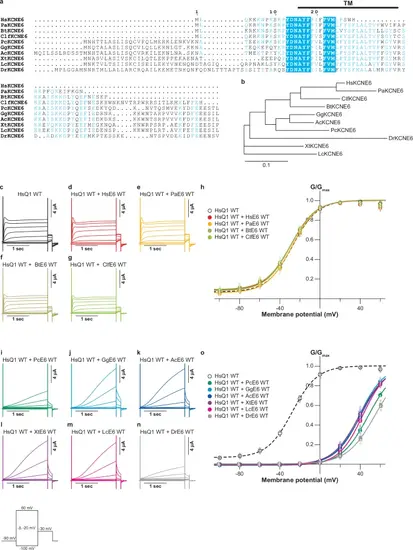Fig. 3
- ID
- ZDB-FIG-250207-14
- Publication
- Kasuya et al., 2024 - Identification of KCNE6, a new member of the KCNE family of potassium channel auxiliary subunits
- Other Figures
- All Figure Page
- Back to All Figure Page
|
KCNE6 proteins from lower vertebrates are functional.Sequence alignments (a) and phylogenetic tree (b) of KCNE6 proteins from human (HsKCNE6), Sumatran orangutan (Pongo abelii) (PaKCNE6), cow (Bos taurus) (BtKCNE6), dog (Canis lupus familiaris) (ClfKCNE6), koala (Phascolarctos cinereus) (PcKCNE6), chicken (Gallus gallus) (GgKCNE6), green anole (Anolis carolinensis) (AcKCNE6), tropical clawed frog (Xenopus tropicalis) (XtKCNE6), coelacanth (Latimeria chalumnae) (LcKCNE6), and zebrafish (DrKCNE6). Representative current traces (c–g) and G-V relationships (h) of HsKCNQ1 WT alone as well as HsKCNQ1 co-expressed with HsKCNE6 WT, PaKCNE6 WT, BtKCNE6 WT, and ClfKCNE6 WT. Representative current traces (i–n) and G-V relationships (o) of HsKCNQ1 co-expressed with PcKCNE6 WT, GgKCNE6 WT, AcKCNE6 WT, XtKCNE6, LcKCNE6 WT, and DrKCNE6 WT. Error bars indicate ± s.e.m. for n = 5 in (h,o). |

